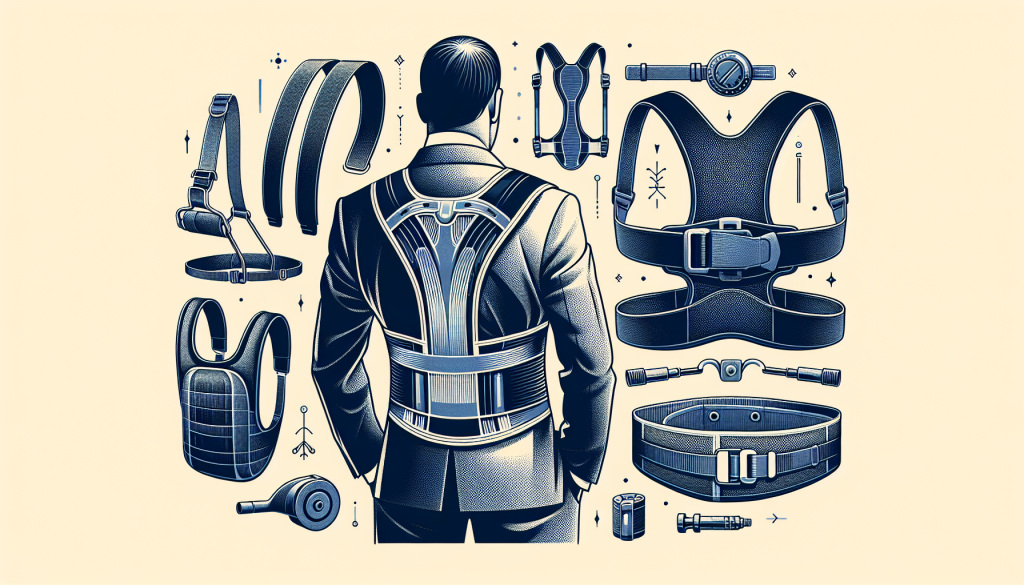The Ultimate Guide To Back Support Braces And Belts
Are you suffering from back pain and looking for a solution to alleviate your discomfort? Look no further than the ultimate guide to back support braces and belts. In this comprehensive article, you will discover everything you need to know about these supportive devices, from their benefits and uses to tips on finding the perfect fit for your needs. Say goodbye to back pain and hello to a more comfortable and supported lifestyle.

Different Types of Back Support Braces
When it comes to finding the right back support brace, there are a few different options to choose from. Each type of brace offers a unique level of support and is suited for specific needs. Here are three common types of back support braces:
1. Rigid Braces
Rigid braces, sometimes referred to as hard braces, are made from stiff materials such as plastic or metal. These braces are designed to provide maximum stability and support for the spine. They are typically recommended for more severe back conditions or after spinal surgeries. Rigid braces restrict movement and help immobilize the spine, which can be beneficial for those recovering from injuries or undergoing spinal rehabilitation.
2. Soft Braces
Unlike rigid braces, soft braces are made from flexible materials such as neoprene or elastic. These braces offer a moderate level of support and are often used for less severe back conditions or as a preventive measure. Soft braces provide compression and warmth to the back, which can help alleviate muscle fatigue and provide a gentle level of support. They are also more comfortable to wear for extended periods, making them a popular choice for everyday use.
3. Corset Braces
Corset braces, also known as elastic braces or lumbar belts, are designed to provide targeted support to the lower back. They typically wrap around the waist and are secured with adjustable straps. Corset braces offer a balance between rigidity and flexibility, providing support to the lumbar region while allowing for some range of motion. These braces are often used for conditions such as muscle strains, herniated discs, or lower back pain.
Benefits of Using Back Support Braces
Using a back support brace can offer a range of benefits for both short-term relief and long-term spine health. Here are some key advantages of using back support braces:
1. Improved Posture
One of the primary benefits of wearing a back support brace is improved posture. Back support braces help position the spine in its natural alignment, reducing slouching and promoting better posture habits. By keeping the spine properly aligned, these braces can help alleviate stress on the spine, neck, and shoulders, ultimately leading to improved overall posture.
2. Reduced Strain on the Back
Back support braces are designed to provide additional support to the back muscles and ligaments. By distributing the load more evenly across the back, these braces can help reduce strain on specific areas of the back, particularly the lumbar region. This can be especially beneficial for individuals who engage in physically demanding activities or jobs that require repetitive lifting, bending, or twisting motions.
3. Prevention of Injuries
In addition to offering support during recovery, back support braces can also be used as a preventive measure to reduce the risk of injuries. By providing stability and limiting excessive motion, these braces can help protect the back from sudden movements or accidents that could lead to strains, sprains, or other injuries. Athletes or individuals who participate in high-impact sports, for example, can benefit from using a back support brace to minimize the risk of back-related injuries.
4. Pain Relief
Back support braces can provide temporary pain relief for individuals suffering from chronic back pain or acute injuries. The compression and support provided by these braces can help reduce inflammation, alleviate muscle spasms, and provide a sense of stability to the affected area. However, it is important to note that back support braces should not be used as a long-term solution for pain, and consultation with a healthcare professional is recommended for individuals experiencing persistent or severe pain.
How to Choose the Right Back Support Brace
With so many back support braces available on the market, it can be overwhelming to choose the right one for your specific needs. Here are some factors to consider when selecting a back support brace:
1. Consider Your Needs
Before purchasing a back support brace, it’s important to assess your specific needs and the reason for using a brace. Are you looking for general back support, or do you have a specific condition that requires targeted support? Understanding your needs will help narrow down your options and find a brace that is most suitable for you.
2. Consult with a Healthcare Professional
If you are unsure about which type of back support brace is best for you, it is always advisable to consult with a healthcare professional. They can assess your condition, provide recommendations, and ensure that the brace you choose is appropriate for your specific back health needs.
3. Check for Proper Fit
A proper fit is crucial for the effectiveness and comfort of a back support brace. Make sure to measure your waist or the area where the brace will be worn and compare it to the sizing guidelines provided by the manufacturer. The brace should fit snugly but not be too tight or restrictive. A properly fitted brace should provide support without causing discomfort or impeding your range of motion.
4. Evaluate the Material and Quality
The material and quality of the back support brace can impact its durability, breathability, and overall effectiveness. Look for braces made from high-quality materials that are breathable and moisture-wicking to ensure comfort, especially if you plan on wearing the brace for extended periods. Additionally, consider the overall construction and durability of the brace to ensure it will withstand regular use.
Common Conditions That May Require Back Support Braces
Back support braces can be beneficial for a variety of back conditions and injuries. Here are some common conditions that may require the use of a back support brace:
1. Herniated Discs
A herniated disc occurs when the soft cushioning discs between the vertebrae in the spine rupture or bulge, often causing pain and discomfort. A back support brace can help alleviate pressure on the affected area and provide support to the spine, promoting proper alignment during the healing process.
2. Sciatica
Sciatica is a condition characterized by pain that radiates along the sciatic nerve, which runs from the lower back down the back of each leg. A back support brace can help relieve pressure on the sciatic nerve and provide stability to the lower back, reducing pain and discomfort associated with sciatica.
3. Scoliosis
Scoliosis is a condition characterized by an abnormal curvature of the spine. Depending on the severity of the curvature, a back support brace may be recommended to help stabilize the spine and prevent further progression of the curvature, particularly in children and adolescents.
4. Muscle Strains
Muscle strains in the back, such as those caused by overexertion, lifting heavy objects, or sudden movements, can benefit from the additional support provided by a back support brace. The brace can help reduce strain on the muscles and promote healing by limiting excessive motion.
5. Arthritis
Arthritis in the spine can cause pain, stiffness, and inflammation. A back support brace can help alleviate pressure on the arthritic joints and provide support to the spine, reducing pain and improving mobility.

How to Wear a Back Support Brace Correctly
Properly wearing a back support brace is essential to ensure maximum effectiveness and comfort. Here are some steps to follow when wearing a back support brace:
1. Positioning the Brace
Start by positioning the back support brace around your waist, ensuring that it covers the targeted area of the back. The brace should sit snugly above the hips and below the ribcage, providing support to the lumbar region. Make sure the brace is centered and aligned with your spine.
2. Adjusting the Straps
Most back support braces come with adjustable straps to allow for a customized fit. Begin by securing the main closure or straps in the front of the brace, tightening them until the brace feels snug but not too tight. Then, adjust the side straps or secondary closures to achieve a comfortable level of compression and support.
3. Finding the Right Amount of Support
Finding the right amount of support may require some experimentation. If the brace feels too restrictive or uncomfortable, try loosening the straps slightly. On the other hand, if the brace feels too loose or fails to provide adequate support, tighten the straps accordingly. You should feel a gentle level of support and compression without any discomfort or restriction of movement.
Potential Risks and Limitations of Back Support Braces
While back support braces can be beneficial, it’s important to be aware of their potential risks and limitations. Here are some considerations to keep in mind:
1. Restricted Range of Motion
Depending on the type of back support brace you choose, you may experience a restricted range of motion. Rigid braces, in particular, are designed to limit movement to promote healing or prevent excessive motion. If you require full mobility, a soft brace or corset brace may be a more suitable option.
2. Muscle Weakness
Continual reliance on a back support brace can lead to muscle weakness. The brace provides external support to the back muscles, which may cause the muscles to become dependent on the brace. To avoid muscle weakness, it is important to incorporate exercises and stretches to strengthen the back muscles when using a back support brace.
3. Dependence on the Brace
Back support braces should be used as a temporary measure for pain relief or support. Over-reliance on the brace can cause the muscles and ligaments in the back to weaken, leading to increased vulnerability to injuries. It is important to consult with a healthcare professional to determine the appropriate duration of brace usage and to develop a plan for gradually reducing dependency on the brace.
Tips for Maintaining and Cleaning Back Support Braces
To ensure the longevity and effectiveness of your back support brace, it is important to develop a regular maintenance and cleaning routine. Here are some tips to help you properly care for your brace:
1. Regular Cleaning
Back support braces can accumulate sweat, oils, and odors over time, so it’s important to clean them regularly. Follow the manufacturer’s instructions for cleaning your specific brace, but generally, handwashing with mild soap and warm water is recommended. Avoid using harsh chemicals or bleach, as they can degrade the material of the brace.
2. Proper Storage
When not in use, store your back support brace in a clean and dry place. Avoid exposing the brace to excessive heat, sunlight, or moisture, as these can cause damage to the materials and compromise the brace’s effectiveness.
3. Replacing When Necessary
Over time, the elasticity and effectiveness of a back support brace may diminish. It is important to regularly evaluate the condition of your brace and replace it when signs of wear and tear are evident. A worn-out brace may not provide the necessary support and may even cause additional discomfort or injury.
Exercises and Stretches to Complement Back Support Brace Use
While back support braces can provide valuable support and relief, incorporating exercises and stretches into your routine can further enhance their benefits. Here are some exercises and stretches that can complement the use of a back support brace:
1. Core Strengthening Exercises
Strong core muscles can help support the spine and improve overall back health. Exercises such as planks, bridges, and bird dogs can target the core muscles, helping to stabilize the spine and reduce strain on the back.
2. Lower Back Stretches
Stretching the lower back can help relieve tension and improve flexibility. Cat-cow stretches, seated forward bends, and child’s pose are some examples of stretches that can target the muscles in the lower back.
3. Postural Correction Exercises
Poor posture can contribute to back pain and discomfort. Performing exercises that promote postural correction, such as shoulder retractions, chest stretches, and wall angels, can help improve posture and alleviate strain on the back.
Frequently Asked Questions about Back Support Braces
Can I Wear a Back Support Brace All Day?
While it may be tempting to wear a back support brace all day for constant support, it is generally not recommended. Extended and constant use can lead to muscle weakness and dependence on the brace. Consult with a healthcare professional to determine the appropriate duration of brace usage based on your specific needs.
Are Back Support Braces Only for People with Chronic Pain?
Back support braces can be used by individuals with both chronic pain and acute injuries. They can provide temporary relief and support for acute injuries, as well as help manage chronic pain conditions. However, it is important to consult with a healthcare professional to determine the appropriate use of a back support brace based on your specific condition.
Can I Use a Back Support Brace During Exercise?
Back support braces can be used during exercise to provide additional support and stability. However, it is important to choose a brace specifically designed for exercise and ensure that it allows for proper range of motion. Consult with a healthcare professional or a fitness expert to determine if using a back support brace during exercise is appropriate for you.
Conclusion
Back support braces can be valuable tools for improving posture, reducing strain on the back, preventing injuries, and providing pain relief. By understanding the different types of braces, their benefits, and limitations, you can make an informed decision on which brace is most suitable for your needs. Remember to consult with a healthcare professional to ensure proper usage and to develop a comprehensive approach to back health that includes exercises, stretches, and proper maintenance. With the right back support brace and a well-rounded approach to back care, you can enhance your overall spinal health and enjoy a pain-free life.




